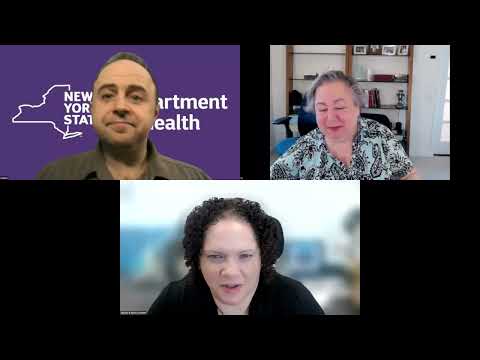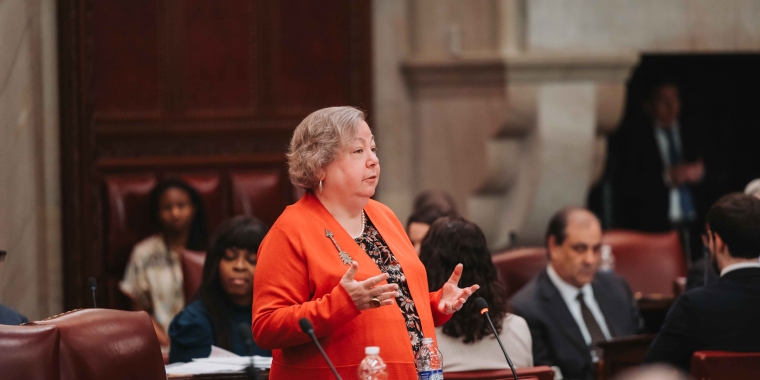
Testimony Before the New York City Council on the East River Realty Corporation’s Application to Rezone the First Avenue Properties and Manhattan Community Board 6’s Proposed 197a Plan on February 25, 2008
Liz Krueger
July 15, 2010
My name is Liz Krueger and I am the State Senator representing the 26th State Senate District, which includes the proposed rezoning area. I appreciate this opportunity to comment on the East River Realty Corporation’s (ERRC) proposal to redevelop the First Avenue Properties, commonly known as the “former Con Edison sites.” I regret that, because the State Senate is in session today in Albany, I am unable to appear in person.
I would also like to reiterate my full support for the 197-a plan for the eastern half of Manhattan Community Board 6 proposed by the board and the East Side Rezoning Alliance. Attached, you will find the detailed testimony I presented at the first City Planning Commission hearing on this plan on September 27, 2006. A comprehensive land-use plan for the East Side of Manhattan is clearly needed to ensure that the numerous development projects under consideration or already approved in the area are not evaluated in a vacuum. However, given my limited time, my testimony today will focus on the ERRC’s rezoning proposal.
The former Con Edison properties along the East River between 35th and 41st Streets compose the largest remaining area of developable land on the East Side of Manhattan. The residents of the neighborhoods surrounding the proposed rezoning area are faced with a potential development that is unprecedented in its magnitude and range of possible impacts on the community. It is essential that New York City’s government take the concerns and needs of my constituents into account when considering the rezoning of this land. Of course development always has impacts, but the enormous size of this rezoning will have broad ramifications far beyond the specific blocks being considered for significant up-zoning.
I am proud to represent the incredibly talented and dedicated members of Community Board 6, in whose district this rezoning is being proposed. The board has a unique understanding of this neighborhood, and their participation should be embraced. Community Board 6 has worked for more than eight years studying, analyzing, and discussing the nature of development that should take place on the former Con Ed sites and surrounding neighborhood, recently laying out in its own visions for the area in 197a and 197c plans submitted to the Department of City Planning. The community board’s 197c plan presents an alternative rezoning scenario for the First Avenue Properties that would enable the construction of a large residential development project on the sites, while preventing many of the negative impacts of the ERRC’s proposal and providing numerous benefits to the community. Many aspects of this alternative plan were studied in the Final Supplemental Environmental Impact Statement (FSEIS) conducted for the ERRC proposal, and as such, are considered “in scope” and can be implemented in the rezoning process.
Similarly, I am extremely lucky to jointly represent the East Side with city, state, and federal elected officials who fully appreciate the importance of this rezoning to the future of the neighborhood and larger city. For more than two years, the elected representatives of the sites being rezoned, as well as representatives of the surrounding neighborhoods, have been meeting on a regular basis with Community Board 6 and other local organizations to develop a sustainable shared vision for the far East Side of Manhattan. I particularly want to thank Councilmembers Dan Garodnick, Rosie Mendez, and Jessica Lappin for taking such proactive roles throughout this process.
The sites being discussed offer the rare chance to create an exceptional project that is connected to both the city and the waterfront. If sensibly developed as part of a larger community vision, this project represents a unique opportunity to significantly strengthen the city’s transportation infrastructure, as well as to add desperately needed affordable housing, open space, and school facilities to the East Side. The development of these parcels truly represents a once-in-a-lifetime opportunity that New York City must get right. With these unique opportunities, however, there is the potential to make colossal mistakes.
Unfortunately, the rezoning proposal submitted by the ERRC does not take full advantage of the rare opportunities we have before us, and threatens to overwhelm the surrounding neighborhood. The ERRC proposal would lead to significant over-development that is inappropriate for the far East Side of Manhattan. It would severely overburden local services and infrastructure, would have disastrous effects on the area’s traffic and public transportation, fails to provide sufficient access to the waterfront, and would cast significant shadows over the neighborhood’s already limited open space.
I appreciate the ERRC’s attempts to address some of the community’s concerns by incorporating affordable housing and space for a K-8 public school in its proposal. Additionally, I am pleased by many of modifications the City Planning Commission made to ERRC proposal. The decisions by the City Planning Commission to limit the heights of the buildings to 80% of the proposed height if no affordable housing is provided, to prevent the transfer of a plaza bonus from 685 First Avenue across the avenue, and to require the developer to construct the new school during the first phase of construction were particularly important. However, despite these improvements, I cannot support the ERRC proposal in its current form. Below, I offer comments on a number of portions of the developer’s proposal that are of particular concern and importance to my constituents.
The proposed development is too large and out of character with the neighborhood.
ERRC proposes to construct seven massive towers—six residential and one commercial—ranging up to 705 feet and 69 stories in height. According to the FSEIS, the towers would add more than 3,753,600 square feet of residential space (approximately 4,166 apartments), 1,532,437 square feet of commercial space (office space for close to 7,000 workers), and 1,554 parking spots to the neighborhood. Buildings of this bulk, height, and capacity would dwarf the existing buildings in the community, cast oppressive shadows on open space including St. Vartan’s Park, Manhattan Place, and Manhattan Plaza as well as on the proposed open space on the First Avenue Properties, and would significantly add to the area’s already overburdened transportation and social infrastructure.
In order to obtain this enormous density, the ERRC has asked the city to rezone the property from a primarily manufacturing district to a commercial district with zoning districts (C4 and C5) that is appropriate for a central business district. C4 and C5 zoning districts are unsuitable for the far East Side of Manhattan which is predominantly residential. The neighborhood surrounding the sites to be rezoned, along First Avenue from 34th to 42nd Streets, is a residential district zoned almost exclusively R8 and C1-9. The area was formerly a manufacturing district, but as each lot along First Avenue became the subject of a rezoning proposal, the Department of City Planning determined C1-9 was the appropriate designation. 685 First Avenue, one of the properties that is the subject of the proposed redevelopment, is already designated C1-9. That zoning designation is the logical one for this area, as it permits high-density residential development and some retail use, consistent with the contextual surroundings.
The far East Side of Manhattan from 14th Street up into East Harlem is made up of thriving residential neighborhoods—along First and York Avenues the United Nations and a number of hospitals are the only substantial exceptions to this residential pattern. The developer’s proposal to introduce more than one million square feet of office space into a residential community already struggling with major traffic congestion and inadequate public transportation simply does not make sense. Similarly, there is no reason to believe that the extension of zoning appropriate to a central business district—such as the C4 and C5 districts proposed by the applicant—as far east as the development parcels is consistent with the city’s zoning and planning policies. In fact, as is evident in the recent Hudson Yards rezoning, the city’s policy is to expand the Midtown Central Business District in the direction of the far West Side. In contrast, it is rational to keep the far East Side as a residential area.
This community needs truly open public space.
With the lowest ratio of public park space per capita of any Manhattan community district, there is no question that my constituents living and working in Community Board 6 suffer from a serious deficiency of open space. This deficit will be greatly exacerbated by the introduction of thousands of new residents and office workers to the neighborhood.
I am pleased that the developer has proposed adding more than 4.8 acres of desperately needed open space to the community. However, I am concerned about the location and usage/nature of this space. The proposed open space in the ERRC proposal is surrounded by massive residential and commercial towers that would cast substantial shadows on the park, and is not guaranteed to remain permanently accessible to the public. As the towers surrounding the open space rise to their full heights of between 47 and 66 stories without setbacks, they will likely feel intimidatingly large and oppressive to people attempting to enjoy the open space. The location of the majority of the open space between several private towers is also likely to make the space seem “private” versus “public and welcoming” to the larger community. In addition, while the ERRC has repeatedly stated that the publicly accessible open space will remain available to the public in perpetuity, many of my constituents have legitimate fears that this space could be improperly made private in the future. Unfortunately, there have been numerous examples throughout my district of public open spaces, which were created through plaza bonuses and thus legally required to remain permanently accessible, that have been illegally closed for years at a time.
The proposed development does not adequately link the community to the waterfront.
Furthermore, I am disappointed that the developer has chosen not to take full advantage of the properties’ location along the waterfront. Over the past fifty years, a number of forces have significantly altered the relationship of the city to its shoreline. For most of New York’s history, the waterfront was the locus for industrial and commercial development. We now have a rare opportunity to reclaim part of the waterfront, and to reconnect the neighborhood to the East River.
Community Board 6 created detailed proposals in its 197a and 197c plans to substantially improve pedestrian access to the waterfront and complete the long-planned waterfront esplanade along the East River. These proposals include the construction of pedestrian bridges and decks over the FDR Drive, the remapping of the streets on the former Con Ed sites, and locating public open space along the waterfront adjacent to, instead of between, the new towers on the property. These proposals would dramatically improve the quality of life on the East Side by providing direct, physical access to the waterfront, and would significantly further the city’s long-stated goal of creating a walkable rim around the island. The community’s plan is also consistent with the Comprehensive Manhattan Waterfront 197-a Plan adopted by the City Council in 1997 and the Department of City Planning’s 2004 Manhattan Waterfront Greenway Plan. Waterfront open space would receive substantially more sunlight since it would not be surrounded by large towers, and would likely feel much more public than space sandwiched between private buildings. Moreover, as a matter of good city planning, it is important that the streets on the First Avenue Properties be formally remapped as public streets. Remapping the streets would improve public access to the proposed open space on the development site, would allow the Police Department to patrol the area regularly, and would help reduce the size of the towers permitted to be constructed on the property. Unfortunately, the ERRC has chosen not to integrate the community board’s ideas into its plans, and fails to provide a direct link between the neighborhood and the waterfront itself.
The proposed development would exacerbate traffic congestion and overwhelm the area’s public transportation infrastructure.
My constituents, as well as all New Yorkers who visit or work on the far East Side, are only too aware of both the traffic congestion already plaguing the area and the inadequate public transportation infrastructure serving the neighborhood. The addition of more than 4,100 new apartments, 7,000 commercial workers, and 1,550 parking spaces, as the ERRC proposes, would have devastating effects on the area’s already overburdened streets, sidewalks, and public transportation infrastructure. Local avenues and streets, the Lexington Avenue subway line, and the cross town busses on both 34th and 42nd Streets are already at or above capacity. The FSEIS found that 81 of the 86 intersections studied are already at levels of service D or worse.
As expected, the FSEIS reveals that the ERRC would have “significant adverse impacts” on the area’s traffic congestion and public transportation routes. On the streets, significant adverse impacts are predicted to occur at 55 intersections in three study areas ranging from the Midtown tunnel to the Queens entrances to the 59th Street Bridge during the morning rush hour, 35 intersections during the midday, 57 intersections in the evening rush hour, and 22 intersections on Saturdays. The FSEIS discloses that many of these impacts are unmitigatable. The proposed development is projected to significantly adversely affect the M16, M34, M42 bus lines, an entrance to the subway at Grand Central Station, and pedestrian circulation throughout the area.
Unfortunately, despite requests from the area’s elected officials and the community board, the FSEIS did not incorporate the city’s plans to implement Bus Rapid Transit on First and Second Avenues in the next few years into its traffic and public transportation analyses. As currently planned, Bus Rapid Transit will shift at least one additional lane of traffic from general automobile use to a bus lane during peak rush hour congestion periods, and will require changes to the timing of traffic signals. As a result, the implementation of Bus Rapid Transit will leave First and Second Avenue with less road capacity than the amount that was studied in the FSEIS, and will clearly affect the traffic patterns and mitigation options in the area; these impacts must be fully studied.
The developer claims throughout the FSEIS that many of these extremely severe impacts can be mitigated, or at least partially mitigated by actions such as the expansion of cross-town bus service, the widening of crosswalks and stairway, improved parking and traffic management and enforcement, and altering traffic lights. However, because every single suggested traffic and transit mitigation measure would have to be implemented and funded by city agencies, there is no guarantee that they would ever take place. Unless the developer is willing to fully fund these service expansions and infrastructure improvements, and the city is entirely committed to executing them in a timely manner, they cannot be viewed as realistic.
Additionally, the ERRC’s proposal to include 1,554 parking spots (945 public spaces and 609 accessory spaces) in the development is likely to further exacerbate traffic congestion. The provision of so many parking spaces is also is contrary to the city’s longstanding policy on parking in Midtown Manhattan, the environmental goals of the Mayor’s PlaNYC, and the new congestion pricing program currently being considered. Article 1 Chapter 3 of the New York City Zoning Resolution strictly limits parking in Midtown Manhattan in order to improve the quality of the air. Exceptions to this policy are only to be made in unique circumstances by the Department of City Planning. The residents who will reside in the buildings on the First Avenue Properties will live within easy walking distance of the Midtown Central Business District and a comprehensive existing public transportation system; their transportation options are likely to be further improved in the future with the implementation of Bus Rapid Transit and the construction of the Second Avenue Subway. In such an environment, walking and public transit use should be strongly encouraged. The provision of more parking spaces than is absolutely necessary encourages additional and unnecessary traffic. As such, I strongly urge the City Council to reject the developer’s application for a Special Permit for more parking spaces than would otherwise be permitted under the Zoning Resolution.
Finally, while the MTA’s environmental impact statement for the planned Second Avenue subway project comprehensively examines capacity issues on the Lexington Avenue subway lines, the ERRC’s FSEIS somehow omits a study of the how the proposed development would impact train capacity and movement on the Lexington Avenue subway lines. The “leave loads” on the Lexington Avenue subway southbound express service already far exceed New York City Transit’s guidelines, leaving passengers with far less than the recommended space of three square feet per person. Leave loads at Grand Central are the highest at any point on the Lexington Avenue Subway, according to MTA data. Such excessive leave loads undoubtedly make for an unpleasant commuting experience, but they also have a far broader impact on the subway’s ability to operate consistently and on-time. As passengers squeeze onto every last square foot of the train, conductors cannot close the doors and trains have difficulty leaving the station—leading to backups throughout the line. Today, Lexington Avenue subway dwell times at Grand Central station stop average 50-60 seconds, far exceeding the MTA’s guidelines of 30-45 second dwell times necessary to maintain the planned 30 trains per peak hour. Anyone who commutes from points north of 42nd Street on the Lexington Avenue express lines during the peak rush has experienced trains operating at slow speeds or stopping just before entering Grand Central Station. This phenomenon will become the norm if even a fraction of the residents and workers of the planned development commute to points south of 42nd Street. It is essential that the final Supplemental Environmental Impact Statement analyze the system-wide impacts of the ERRC’s proposed rezoning on the Lexington Avenue subway line and determine what if anything, can be done to mitigate the potentially disastrous consequences.
This neighborhood desperately needs new and expanded public school spaces.
Just as the excessive density of the proposed development would overwhelm the area’s transportation infrastructure, it would similarly overburden the neighborhood’s highly respected but already overstretched elementary and middle-schools. P.S. 116, the zoned public elementary school for the First Avenue Properties as well as the all of the East Side between 26th and 43rd Streets, had 824 students enrolled in September 2007 in a building designed to accommodate 700. Enrollment at P.S. 116 increased by nearly 15% between June and September 2007 alone. This rapid rise in enrollment has forced the school to increase its average Kindergarten class size to 28, which is substantially higher than that recommended for young students. The other elementary schools in the study area were at 97% capacity in the 2005-06 school year. The community’s middle schools, IS 104 and IS 255, were at 93% and 100% capacity respectively in 2005-2006, but parallel to the experience of PS 116 are projected to increase their populations dramatically in the coming years
According to a report prepared for the School Construction Authority in October 2005, Community School District 2, in which the First Avenue Properties are located, is experiencing the greatest increase in elementary and middle school enrollment in the entire city. The report found that District 2 enrollment is expected to increase by 9.1% between 2004 and 2009, and 24.7% between 2004 and 2014. Enrollment growth in the section of District 2 zoned for PS 116 is expected to be particularly dramatic. 32 high rise buildings, containing thousands of new units, are currently being constructed or converted to residential use within P.S. 116’s catchment area by 2014. The FSEIS estimates that the proposed ERRC project alone would add 417 public elementary school students and 83 middle school students to the neighborhood. If these numbers are accurate, this would put the elementary schools in the study area at 164% capacity and the middle schools at 119% capacity in 2014. There is simply no way that the area’s schools could continue to function, let alone thrive, under such a scenario.
I am pleased that the ERRC has recently recognized that it must play an active role in helping to mitigate the significant impacts its development will have on the neighborhood’s educational facilities. ERRC is currently working with the School Construction Authority to make part of the “community facility” it is constructing on its 616 First Avenue property available to the Department of Education for a 630 seat K-8 public school. This is clearly an important step in the right direction. However, given the scale of the rezoning the developer has requested and the impact the project will have on the public school system, I do not believe it is sufficient. Under the circumstances, the City Council should strongly consider requiring the ERRC to provide space for a substantially larger school on the site.
Any development must include a minimum of 20% affordable housing on-site.
In addition the concerns I have already discussed about the inappropriate density of the proposed project, and the impact this will have on the area’s infrastructure, I am also deeply concerned by the ERRC’s refusal to guarantee that it will make a minimum of 20% of the apartments it builds permanently affordable to moderate and middle-income households. Community Board 6, as well as all the area’s elected officials, have asked the ERRC to include a substantial percentage of on-site affordable housing in any proposed plan. In fact, in the joint comments submitted regarding the Draft Scope of Analyses for the FSEIS in May 2006, all of the area’s elected officials called upon the Department of City Planning to require the inclusion of 30% affordable housing on-site. Despite this, the developer initially submitted a rezoning plan without a single unit of affordable housing. I am pleased that the ERRC entered into discussions with the city’s Department of Housing Preservation and Development, and submitted an amended rezoning proposal that would likely lead to the creation of some affordable housing—either on the First Avenue Properties or in the surrounding neighborhood.
It is my understanding that the developer has agreed to include five of the seven proposed towers in the city’s new “inclusionary housing designated area” program (685 First Avenue and the proposed commercial building would be excluded). Under this revised plan, the ERRC will only be permitted to build the five towers with the square footage it desires if it constructs or preserves affordable housing units that contain total square feet equal to 20% of the towers. Unfortunately, because the revised plan excludes the proposed commercial building and 685 First Avenue, which is the largest of the proposed residential buildings, from the Inclusionary Housing Plan, the total number of affordable units created or preserved will only be equivalent to approximately 15%—rather than 20%—of the total square feet of residential space developed. As such, while the revised First Avenue Properties rezoning plan represents an important improvement over the initial submission, it is not acceptable in its current form. Given the affordable housing crisis facing the city of New York, and the size of the economic benefit that the developer will obtain as a result of the city's rezoning of the property, the provision of 15% affordable housing is insufficient.
The city’s skyrocketing housing costs, along with the loss of hundreds of thousands of previously affordable regulated units in recent years, has created an acute affordable housing crisis for low- and middle-income New Yorkers. According to the 2000 census, 11,227 people living in Community Board 6 live in poverty, nearly 35% of residents of this area face rent hardship burdens as defined by the federal government, and more than 10,000 additional affordable units are needed within the boundaries of the community board simply to meet the needs of existing residents in poverty and/or paying more than half their incomes in rent. Since 2000, the community board has lost thousands of previously affordable Mitchell-Lama and rent regulated homes. This crisis threatens to transform New York into a city of economically and racially segregated neighborhoods, with no room for the middle class. The future of our city is placed at risk as residents are forced out of their homes and communities. The low- and middle-income workers upon whom our economy depends are finding it more and more difficult to get by, with housing either unavailable or so expensive that it impoverishes them. This is why the Department of City Planning has required the inclusion of a substantial amount of affordable housing in every recent major rezoning it has approved.
Whenever an area is rezoned, whether from manufacturing to residential or commercial or allowing increased density, landowners receive a substantial windfall as a result of a public action. Studies conducted by the Pratt Center for Community Development, Policy Link, the Urban Land Institute and others have shown that in some cases land values will grow by more than 500% as result of rezonings. Inclusionary zoning is a way to capture a portion of the new market value created by a public action for a public good. Inclusionary zoning programs have led to the creation of hundreds of thousands of affordable units across the country, while also enhancing mixed-income communities and improving economies.
The ERRC has asked the city of New York to rezone its property from manufacturing to commercial and to dramatically upzone the one parcel already zoned commercial. Under the current zoning governing the property, with the exception of 685 First Avenue, the developer could not construct either residential or office buildings. It is evident that, regardless of the final rezoning approved, through its actions the city will be significantly increasing the value of the land owned by the ERRC. Given the scale of the rezoning, I believe that a 30% onsite affordable housing requirement would be appropriate. Unfortunately, because only a 20% affordable housing component was studied in the FSEIS, I have been informed that a 30% requirement would be “out of scope” and impossible to implement for this rezoning. Therefore, at an absolute minimum, the Department of City Planning should require 20% onsite permanently affordable housing. This requirement should apply to all the buildings developed on the properties, and include the commercial floor area in the bonus structure, as occurs in the Clinton Special District.
A Unique Opportunity to Shape the Future
I strongly urge the City Council to develop a final comprehensive rezoning plan that reflects the character of the far East Side, strengthens the area’s infrastructure, and plans wisely for the future of our city. The decisions that are made in this rezoning process will dramatically affect the character and infrastructure of the far East Side for decades to come.
Thank you for the opportunity to testify today.



